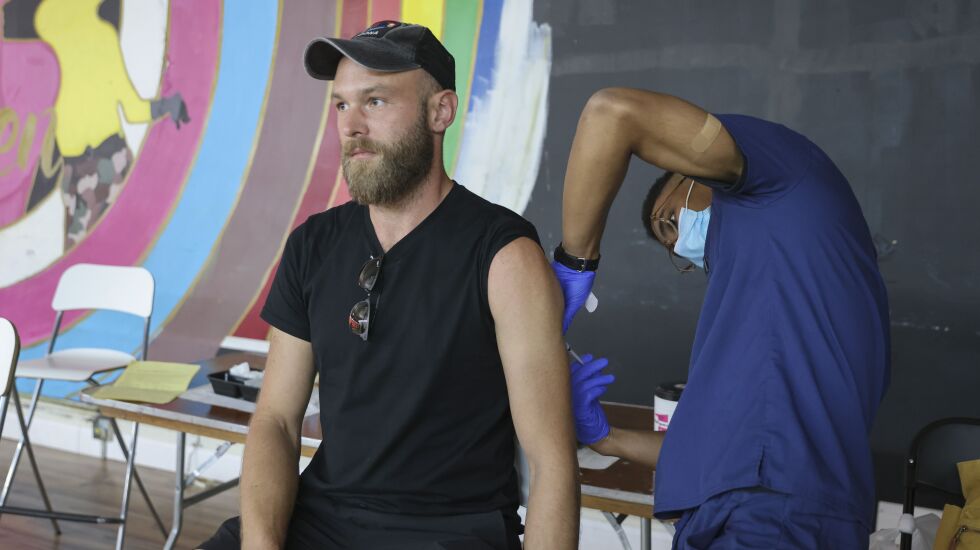
The line to get the monkeypox vaccine at a West Side vaccine site began forming at 11 a.m., three hours before the doors would open. It wrapped around the corner and into the alley.
Some of those waiting leaned against the wall, soaking in the sun.
But every last person in line — 140 in all — got the jab.
They all had come last week to TaskForce Prevention & Community Service, a community center for Black and Brown LGBTQ youth, a site picked by Chicago public health officials for the vulnerable group it supports.
Stanton Hinson joined that queue last Thursday at 11:15 a.m. The San Francisco-based nurse was halfway through a three-month family visit in Belmont Cragin when the Illinois Department of Public Health announced the first case of monkeypox in Chicago.
That was on June 2. By Thursday, the case count had grown to 478.
“It’s starting to run through the community, and everyone here is a sexual being,” he said. “We want to be able to have sex and feel free, and not have to worry about disease if it’s something we can prevent.”
Put off by the wait to get the vaccine elsewhere, the 33-year old came to the Austin site.
“I had tried to go in Boystown, but the line was so long.”
He was vaccinated shortly after doors opened at 2 p.m.

Barely a dozen sites around the city offer the scarce vaccine, leading some shot-seekers to venture well out of their way to get it.
Andrew Vo, a grocery store worker from McHenry, drove 50 miles because he couldn’t find anything closer. The 27-year-old was worried because he fell into one of the eligible groups.
Though anyone can get the virus, most cases in Chicago have been diagnosed in males around age 35, health officials said. The disease has mostly been identified among men who have sex with other men, but city health Commissioner Dr. Allison Arwady has warned the public that monkeypox “is not a gay disease.”

TaskForce, at 9 N. Cicero Ave. has vaccines available on a walk-in basis on Wednesdays and Thursdays, from 2 p.m. to 5 p.m. Doses are administered by staff from Rush Medical Center and UI Health.
Founded in 1990, the community center offers HIV/STI education and prevention; helps people find housing; addresses food insecurity; provides mental health services; and even hosts a Vogue School, where participants can workshop their dance routines.
“Many struggle,” said executive director Chris Balthazar. “They are are exposed to multiple forms of trauma, many engage in injection drug use and have multiple vulnerabilities. But it’s a resilient community, talented and artistic.”
But many showing up for the vaccine are not regulars and are traveling from beyond the neighborhood.
Last Wednesday, 170 doses were administered, more than double their average.
“Quite honestly, the word has gotten out, because we’re probably the only people doing something like this on the West Side,” Balthazar said.

The center hasn’t had to turn anyone away. And for many of those new arrivals, the center’s been a welcome discovery.
Jorge Alcaraz said he would ask about volunteering even if he couldn’t get the shot.
“I’m passionate about uplifting queer youth,” he said. “I was young and queer and wished I had, not a role model, but just the chance to see what people like me looked like when they were older.”
The 29-year-old is the head of diversity, equity and inclusion for a public relations firm.
There was at least one regular in line Thursday — Chris “Blu” Duncan, a photographer and former Amazon worker. Duncan came to the center six years ago for the Vogue School.
Now 26, he decided to get the shot after being in close contact with a person diagnosed with monkeypox.
Despite fears for himself, Duncan worried about the center’s larger community. “We’re so open and amongst each other. We have so many risk factors.”
But the South Side resident struck a note of hope. “We want to come out, and we want to be around each other. Nothing’s going to stop us.”
Michael Loria is a staff reporter at the Chicago Sun-Times via Report for America, a not-for-profit journalism program that aims to bolster the paper’s coverage of communities on the South and West sides.








